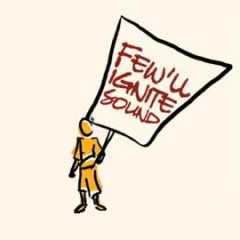"Lentic": Part 10
So, as some of you already know, China truly changed my life. When I arrived in China in the spring of 2007, I had this distinct feeling like I had been here before. The land and its vibration felt familiar, perhaps like a past life memory. Even though I had studied the language before, the more I re-learned it, the more it felt natural in my mouth—even more so than English sometimes.
In that first three months in China, I met a lot of amazing people and was introduced into the music scene here. I played some solo gigs for the first time in years and made great contacts and basically, felt renewed and revitalized and rested.
I returned to Canada with some dreams of making a different kind of music—something I had never made before. I had always loved electronic music like Moloko, Portishead, Tricky, Bjork, Nitin Sawhney, Morcheeba, Imogen Heap, etc. I found myself craving that kind of groove-based expression in my own work.
It just so happened that a friend taught me how to use Garageband one day and I was inspired to put loops with guitar riffs and build a bit of a small home studio. That summer of 2007, I bought an audio interface and began piecing together the riffs I had written with cool drum loops and samples from the Garageband collection. Another friend gave me some additional Jam Packs filled with more loops. People were so kind!
Once I had what felt to be the makings of a song, I’d insert lyrics that were more stream of consciousness than anything else I’d ever written. Nothing was pre-planned and I just let it all flow. It was the first time that I hadn’t started building a song with my guitar or a piano under my fingers. Instead, I had a mouse and headphones. The resulting music was totally new and different. It was exciting!
What’s more, I was employed that summer to translate an Uh Huh Her song’s chorus into Chinese. I enjoyed the job so much that I began to imagine parts of my new songs with Chinese lyrics. “Why couldn’t I sing in Chinese?,” I thought, “That way, at least if I go back to China then people will understand my lyrics!”
Thus began a whole new approach to lyric writing. I remember letting the band hear those first three songs: “So Nice,” “Hollowed Bones,” and another called “Shanghai” that I didn’t include in my final collection of “Lentic” material. The response was polite but seriously lacked lustre. After all, China was my private experience and they couldn’t relate to the messages in the songs, especially when I had to translate them, let alone my pointed attempt to use the 5-note Chinese scale, for instance. I distinctly remember being disappointed that they weren’t as excited about the new music as I was but I resolved to continue the creative streak with or without them.
In the fall of 2007, I journeyed back to China and, of course, met my current partner, Guo Jian. After a long story (that I’m recounting at length in this blog), my relationship with Lyndell finally and formally split up in December of 2007 and I was then standing at a serious crossroads. We still had six months of booking ahead of us, but after that we were planning to go our separate ways. I really wasn’t sure where I was going and what I was doing.
As a result, I clung to my new creation and decided to pursue production assistance, even before all the songs had been written. This new collection of work had blossomed into about six tracks altogether by then, many of which I had worked on during my second trip to China, especially. I approached a variety of producers whose work and style was recommended through my various musical contacts. One of those producers was Tim Rideout.
When I asked Tim what his first impression was of my music or of me in this industry, he wrote this:
“My first impressions of Ember Swift were from watching video footage of her interviews for a documentary film called ‘WHAT IS INDIE?‘ I was the editor on that project and had the pleasure of getting to know her philosophies in this “priviledged” fashion. I found her interesting because she seemed to straddle a line philosophically somewhere between DIY Road-Warrior and Hopeless Dreamer: someone not afraid to get shit done and do it herself, but also someone who never lost sight of core ideals that I hold dear: integrity, honesty and optimism. For me to be able to work with an artist, these qualities are even more important than the music itself, which is why I even considered doing an trans-Atlantic virtual collaboration with an artist I had never met.”
Even though Tim wasn’t the only producer on my radar, he was first one who readily agreed to do an audition mix and then promptly delivered. I sent him my Garageband tracks and he took them up a level into what I immediately felt to be professional territory. I liked his style of doing business and his style of doing production right away. After all, I had very little experience with building all the sounds in a mix, from the drums and bass right up through the atmospheric layers and then to the melody and the finally the vocals. It was a huge challenge for me to get it all out of my head via the computer as this was a methodology that I hadn’t spent years crafting. Tim heard my ideas, improved upon them, and then sent me a revision.
I loved it.
In fact, I listened to that audition mix of “So Nice” about fifty times on repeat because I loved it so much. (Because of the great hard drive crash of 2008, I don’t have it anymore, though, so if you still have that audition track, Tim, send it to me!)
That was in early January, 2008. I remember showing friends who we met up with on the road in January and watching their faces shift from surprise to intrigue as they listened through headphones. It was new for everyone, not just me. It was like nothing I had ever done before.
One of the people I showed was Liz Kelly. I have spent these blogs chronicling the drummers that have come and (sometimes) gone over the years. I would be remiss if I didn’t mention Liz whom we worked with on and off in those final two years and with whom I felt a musical kinship that I really enjoyed. Liz was touring with us that season (January-February, 2008) and her feedback about the track was especially open and positive, while still constructive and encouraging. We worked with Liz mostly when it was the most geographically convenient to have her with us for US-based travel. In a way, when Liz was along, I was reminded of the early days with Cheryl behind the kit. Three female voices and her curly, bouncy, blonde locks all felt like a flashback to those days pre-Y2K!
But, getting back to the “Lentic” album project, I also really loved the idea of Tim and I working together in a collaborative fashion, creatively. I didn’t have all of the ideas, for instance, and I wanted to work with someone who was as inspired by my ideas as I was by his. We just seemed to immediately be on the same page about the songs and this couldn’t have been better timing.
Lyndell and I had been musical comrades for years. Having just split up and in the midst of struggling through our last six months of pre-scheduled shows together, our bonds on all levels were severed. She didn’t want to play with me anymore (even though I would have happily continued a music relationship with her) and I was devastated to be looking down the path at the end of an era. I truly missed her (and still do, musically) and really couldn’t understand why she would choose to abandon over twelve years of musical collaboration. I’ve since come to understand her need to do so, but it was a hard time.
So, bonding with someone else, musically, at this time was, well, vital. Meeting Tim helped me to continue to want to make music, whereas I may just have hung up my hat.
What’s more, I had no one left to please except myself. I had no band on board. I had no partner. After the summer, I also had no more agency (as they wanted to work with Lyndell and I as a team or not at all). I had no more house to aspire to be home in (someone had to move out). In other words, I had absolutely nothing left to lose.
Tim and I began working on the project in earnest that winter and we worked slowly, stepping up the intensity in the fall when I was back in China full time. All in all, it took us over a year to complete it, but come spring of 2009, “Lentic” was born.
I asked Tim about the process of recording “Lentic” and whether or not he could cite the challenges:
“The biggest challenge of Lentic was the most fundamental: creative collaboration via communication. We did this record while being thousands of miles apart. Our options for communication were only asynchronous ones: either email or Skype – and Skype was mostly after-the-fact because of the time difference. So in order for me to even come close to being efficient, I had to come up with something that Ember would love the very first time she heard it. This is always desirable, but particularly so in this case since a typical creative exchange that would take minutes in person could take weeks over the Net.
The other learning curve was learning to work together creatively. Not so much in terms of the nuts and bolts of music and which chord should go where, but more how to communicate our differences. This is never easy in person – so imagine what it is over the internet: no body language, no context, no smiles, no reassurance. So if I need to communicate that “I don’t agree that the note you sang in the harmony on the B section is correct in bar 7,” it’s all the more difficult because I have to make an even better argument for my case since we’re communicating asynchronously. On more than one occasion, this was difficult for the two of us, for a number of reasons including distance and just the basic fact that we had never established a working rapport prior to this. Some exchanges were very trying for me as a producer who is genuinely trying to make the best music he hears. When an artist disagrees, I need to establish where the disagreement is coming from – the ears, the head or the heart. This is infinitely more difficult over the Internet and requires a great deal of time and patience on the part of both parties.”
As I’ve mentioned, I was going through some tough transitions in my life during the making of “Lentic,” and so I wasn’t always the most stable party. Tim taught me a lot about communication through the process. His kindness, respectfulness, and maturity exceeded my own and was humbling. For instance, I occasionally felt defensive with his choices (as this was even more of a stretch for me than working with Graham had been, since we were each contributing creatively to the arrangements and the specific musical parts) and I had to wrestle with my control issues throughout the experience. Don’t forget that I was all the way across the world and navigating a nasty, “divorce”-style break-up in one area of my life and so, as a result, I sometimes couldn’t distinguish the allies for the foes. My “trust barometer” was completely out of whack.
So, first of all, I credit Tim and his amazing patience in the making of “Lentic.” I also credit him for a set of ears that are among the most musical, knowledgeable, open-minded, and creative in the business. It’s no wonder he is now so in demand in the film and television world for not only his compositions, but also for his professionalism. (This is Tim’s studio’s site: FibiSonic.)
While I was writing the songs for Lentic, I realized there were a few that I wanted to include in the project even though they weren’t in the “folktronic” vibe. One of those songs was “What Were You Thinking?,” which had been written after Lyndell’s and my good friend committed suicide next door to our home in Dalkeith. It was a shocking experience and I still miss her very much. In fact, “Float” and “What Were You Thinking?” were both about my friend, Shannon, and I really wanted to include these two songs on the record, even though one was a reggae song and the other was a jazzy, pop, singer-songwriter piece.
Tim rolled with these songs beautifully and, in the end, I think “What Were You Thinking?” might be one of the strongest tracks on the record, despite it being the closest to the old “Ember Swift” material in vibe and energy. Most of the media outlets that reviewed the record agreed. It stood out on the album, perhaps even more so since it was set against the “folktronica” songs. What’s more, I think it was the one song that spoke to what people were expecting from an “Ember Swift” release. Of course, this wasn’t intended as an Ember Swift release…
I named the album “Lentic: the new project by Ember Swift” because I wanted to redefine. At the time, I was really sensitive to the fact that, for the first time since 1997 (12+ years!), Lyndell Montgomery’s musicianship was not present in one of my productions. After so many years of being a duo (despite Lyndell never wanting her name in the foreground), I was worried that people wouldn’t think it was appropriate of me the use of my own name for just my own use. I had used that name to represent (at minimum) two people for so long. I therefore began brainstorming how I could rename my new project something completely different and hopefully the opposite in meaning to “Ember Swift.” After all, I gone off in an opposite direction in so many ways in my life!
Lentic means “of or related to living in still waters.” Since “Ember” means fire and “Swift” means fast, it was the “slow water” equivalent to a reinvention. I also hoped that this combined naming (i.e. adding “the new project by Ember Swift”) would help the re-branding effort. It would be a transitional period down a path of this new musical direction with a new band name that people would hopefully follow separately to the “Ember Swift” material.
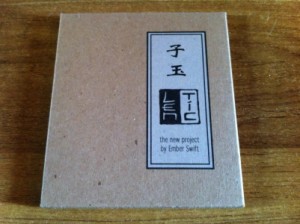 And the real truth is that I feared that my name wasn’t enough without Lyndell. That I wasn’t enough. Ironically, I engaged in the full composition of these songs from the bottom up (alongside of Tim, of course) and so was responsible for much more, musically, than I ever had been before. The fact that I went through any doubt as to my musical abilities and, by extension, my rights to use my own birth name associated with a project that I was spearheading now seems ludicrous. But, crazy times bring out the crazy in us.
And the real truth is that I feared that my name wasn’t enough without Lyndell. That I wasn’t enough. Ironically, I engaged in the full composition of these songs from the bottom up (alongside of Tim, of course) and so was responsible for much more, musically, than I ever had been before. The fact that I went through any doubt as to my musical abilities and, by extension, my rights to use my own birth name associated with a project that I was spearheading now seems ludicrous. But, crazy times bring out the crazy in us.
 I decided to release two versions of the album, as well. The first was a simple, cardboard package that I sourced from a manufacturing company out of Oregan state called Stumptown Printers. I wanted to use 100% post consumer recycled paper printed with vegetable inks and I was willing to pay a bit more for it. There was be no lyric booklet in this package, just the simple CD. It was affordably priced for the fans at only $10 a unit.
I decided to release two versions of the album, as well. The first was a simple, cardboard package that I sourced from a manufacturing company out of Oregan state called Stumptown Printers. I wanted to use 100% post consumer recycled paper printed with vegetable inks and I was willing to pay a bit more for it. There was be no lyric booklet in this package, just the simple CD. It was affordably priced for the fans at only $10 a unit.
The fancy packaging, however, was a marketing experiment that was probably the smartest business move I have ever made, product-wise:
It is a silk-covered book in the traditional Chinese style (featuring three different silk patterns for those who wanted to collect the different ‘looks’). The CD was set into the back cover and the pages featured all the songs translated into both languages. So, if I were singing in Chinese, the lyrics would appear on the left in Chinese and on the right in English. If I were singing in English, vice versa. These books were priced at $40 each and I only made 500 of them. I signed and numbered them all (with the exception of about 20 units that were misplaced that I now call the “rogue copies”) and these beautiful pieces of art helped to finance the early “Lentic” tours.
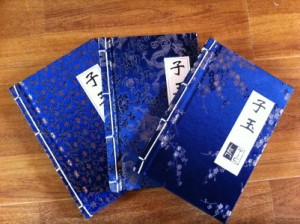 Both designs were implemented by my dear friend and artist Suzy Malik, who was now doing graphic design in addition to photography and illustration work. I had never worked with Suzy in this full way, but she was wonderful and extremely easy to work with. Her ideas for a clean and classy design were absolutely beautiful and I am so glad that I engaged her on this project. I even submitted these books for the packaging component of The Junos but didn’t get a mention. It’s no worries, though, what matters is that I believed it deserved that level of recognition! In the end, we have to believe in what we do, right?
Both designs were implemented by my dear friend and artist Suzy Malik, who was now doing graphic design in addition to photography and illustration work. I had never worked with Suzy in this full way, but she was wonderful and extremely easy to work with. Her ideas for a clean and classy design were absolutely beautiful and I am so glad that I engaged her on this project. I even submitted these books for the packaging component of The Junos but didn’t get a mention. It’s no worries, though, what matters is that I believed it deserved that level of recognition! In the end, we have to believe in what we do, right?
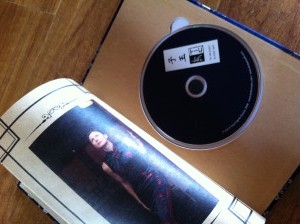 Conceptually, the books were my idea (thanks to the inspiration from some beautifully bound books that Guo Jian owned) and I trekked down to the wholesale fabric markets in the Southern section of Beijing and hand picked the silk patterns. I then hauled heavy bags of silk back home to my Northeastern Beijing apartment and delivered them to the manufacturing company myself, along with mock-ups of my design. Here in China, unusual designs are no problem. They’re used to not working off of templates and were more than willing to take my concept and make it into a reality. The quality and service were impressive.
Conceptually, the books were my idea (thanks to the inspiration from some beautifully bound books that Guo Jian owned) and I trekked down to the wholesale fabric markets in the Southern section of Beijing and hand picked the silk patterns. I then hauled heavy bags of silk back home to my Northeastern Beijing apartment and delivered them to the manufacturing company myself, along with mock-ups of my design. Here in China, unusual designs are no problem. They’re used to not working off of templates and were more than willing to take my concept and make it into a reality. The quality and service were impressive.
Miraculously, I received funding for the project from the Canada Council of the Arts. Officially, it is the first recording project in my entire career history for which I received public funding. Keep in mind that I applied for funding for at least 75% of the other recording projects, but was never successful. I have been successful in the realm of tour funding, however, so I’m not complaining. I’ve been a recipient of assistance from various funding bodies, to be sure, but this particular grant was finally for a recording project. What’s more, it was a “Specialized Music” grant and thus supported Lentic’s musical ‘weirdness’.
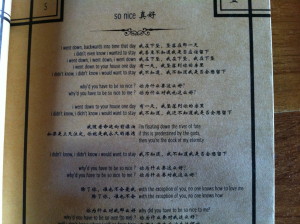 Lentic features both English and Mandarin lyrics (in the same song, save one song that is entirely in Chinese) and traditional Chinese instrumentation set against modern, Western electronic music. It was obviously not geared for a commercial market and this is precisely what earned it its existence through Canada Council. Without this funding, it’s hard to say if the album would exist today.
Lentic features both English and Mandarin lyrics (in the same song, save one song that is entirely in Chinese) and traditional Chinese instrumentation set against modern, Western electronic music. It was obviously not geared for a commercial market and this is precisely what earned it its existence through Canada Council. Without this funding, it’s hard to say if the album would exist today.
After more than eight months off the stage, I contacted Adam Bowman back in Canada to see if he would be interested in helping me a assemble a band to replicate the music that Tim and I had created. To my delight, Adam really liked the finished project and got straight to work on helping me find the right players to bring it to life on stage. We became a five-piece band virtually overnight featuring me on guitar and vocals, Adam Bowman on drums and samples, Cheryl Reid on percussion and samples, Joni Nehrita on keys and backing vocals, and Matthew Lima on bass and backing vocals. (Later, Roger Williams replaced Matthew Lima due to a scheduling conflict).
I arrived back in Canada that spring and immediately took the band on the road for shows in various venues that I had always loved. I booked the tour myself, remotely, and decided to only play the venues I enjoyed playing and that would be appropriate for this new music. We did a release tour with dates in Ann Arbor and a few other Michigan locations, the Chicago area, a few dates in Wisconsin, then Connecticut, Montreal, and the Ottawa area (to name only a few of the stops as I can recall). These dates also included a release performance in Toronto at Hugh’s Room, once again.
I was back in to North America in the summer of 2009 and we did a few more shows. Then I came back once again in the fall of 2009 for some choice performances before piling the six of us (including my partner Guo Jian who played the guzheng, a traditional Chinese instrument) onto a plane bound for Australia in January of 2010. I had a tour booked there for the first time in three years and it included the Woodford Folk Festival and Peat’s Ridge Music Festival as well as many other stops along the East Coast. I took a big risk on my return to the land down under with a six-piece band, a new sound, a new band name, and a fairly different world view.
Sadly, that tour in Australia wasn’t nearly as successful as I had hoped, I’m afraid. I came home in the red and full of bewilderment as to the reasons why. Had I waited too long between Australian tours? Was the music not what people wanted? Was there some sort of animosity towards China there that I didn’t understand? None of these questions could be answered adequately. They never will be answered.
Afterwards, the Lentic five-piece band and I did one more travelling engagement out to British Columbia in March of 2010 for a showcase event. That, too, didn’t go very well. I first went out with just Cheryl Reid and we did a duo show in Vancouver that I quite enjoyed. After the showcase, I stayed a bit longer, as well, and did a solo show on Bowen Island that I also really enjoyed, but the full band experience was becoming strained and financially illogical.
At the time, I was working with a new agent who was convinced that the Lentic project should enter into the theatre market in Canada. In fact, she specialized in these kinds of bookings. But, with our unsuccessful west-coast showcase, it turned out that the theatre program presenters weren’t as thrilled with the “Lentic” project as we were. After a year of working with Tammy Fox and her company The Collection Agency, she and I went our separate ways. Throughout that whole year, we didn’t do a single theatre performance.
The thing is, when “Lentic” was offiially released, I slowly began to understand that people either loved it or hated it. In fact, there were few who were ambivalent. I got some glowing reviews from fans swearing it was the best thing I had ever released. I also got a lot of silence from fans too and a lack of predicted sales that reflected a certain disdain for the electronic aspects, perhaps; or a disdain for Lyndell’s absence, perhaps; or a disdain for the presence of Chinese lyrics, perhaps.
But, it didn’t matter. I loved it. By this time, I was losing interest in analyzing the reasons why people didn’t feel the same way. I think “Lentic” helped me to finally stop caring what anyone else thought. I had nothing to prove to anyone.
When I asked Tim what his final impressions were of the project, he wrote:
“When the project was finally finished, I knew we had a winner. In my eyes and ears, it was quite possibly the best work Ember Swift had ever done. It was pristine, well-crafted, sonically deep and rich, lyrically clever and structurally sound. I was – and still am – deep satisfied with and proud of the project. It sits apart from her previous projects as being a true “studio album.” The difference being that her other projects are “song-writing” albums born of live performance and/or the true songwriting process. Lentic was much more of a laboratory process, making tracks from songs, and songs from beats and beats from bits and bits from parts, etc.”
He went on to say more about what I touched on above, but much more eloquently than I could have:
“Unfortunately, the great strength of Lentic is also its fatal flaw. The artistic leap of faith that Ember took was one of chasm-ic proportions – an artistic rift so great as to alienate this record from the rest of her catalogue, sonically speaking. It just sounds incredibly different from other records she’s done. To her marketing’s credit, she *did* call the project “Lentic” to differentiate it from the Ember Swift her fans know and love. But I think commercially, the album has been passed over and misunderstood.
Was this artistic evolution? Folly? A result of great changes in her personal life needing great change artistically? Perhaps all of the above. But was Lentic a mistake? An error in judgement? A shitty record? Not on your life – and I’ll tell you why: we had so much *fun* making this record and are truly so proud of it that none of that matters. The record can stand on its own as a truly great co-creation. It sounds amazing. It was done over the Internet. We did the impossible and made it sound like a million bucks. If the critics and fans don’t “get it” yet, that’s ok. Maybe they will eventually. Perhaps Lentic is destined to be the “Pet Sounds” release of Ember Swift: an amazing artistic and technological achievement to those in the know. It may take time for appreciation of Lentic to grow. Only time and “Still waters” will tell. All I know is that I’m extremely happy with the way it turned out and wouldn’t change a thing.”
And I second that.








